.avif)
Quick Start & Core Concepts
Welcome to Hey Feelings Academy! We're thrilled to have you here.
Hey Feelings for Therapists is a dedicated version of Hey Feelings Academy designed for child psychologists and therapists.
We’re here to help you make your sessions more engaging, playful, and effective – whether you work with groups or 1:1. This onboarding will give you a clear overview of how Hey Feelings works, how you can use it in live or online therapy, and how it may support your daily practice.
What is Hey Feelings?
Hey Feelings is an engaging, play-based system for teaching social-emotional learning (SEL) to children aged 4–8. It was created to help children build the essential emotional skills they need before adolescence – empathy, self-awareness, and resilience – in a way that feels natural, joyful, and easy to use.
It can be used in:
- Group sessions (Social Skills Training, group therapy sessions)
- 1:1 sessions, including remote therapy via video calls (pilot feature)
Children play and have fun, while the therapist uses the conversations and activities as opportunities to help them understand their emotions and overcome challenges.
How does it work?
Hey Feelings Therapy combines digital tools with physical products, giving therapists maximum flexibility:
🎲 Hybrid Board Games – interactive board games you can launch instantly on any screen (TV, Smartboard, or Projector), and play them in-person or remotely. The therapist will soon be able to customize cards and questions for individual or group needs (feature coming soon).
📚 Emotion Books & Cards – stories, activities, and prompts designed to deepen emotional reflection. In therapy, these become tools for guided 1:1 or group discussions, social-emotional learning, and practicing regulation strategies during therapy, and at home.
Physical Tools for Therapy
In addition to the digital platform, Hey Feelings offers physical products that are ideal for starting therapy, especially in live sessions:
- Board Games for Live Sessions
- Hey Feelings Deluxe – book-and-board games for 2–4 players. It includes special cards created for children with ADHD/ASD, and in the future, will support card personalization and even publishing your own therapeutic card sets.
- Run for Diamonds – a simpler book-and-board game for small groups (up to 4 players). Great for first sessions to quickly engage children in play.
- Hey Feelings Toys
- Large Hey Feelings plushies bring the characters to life in any therapy room — kids identify with the heroes from our games and journey together with them through the Emotion Worlds.
- They serve as comfort objects and playful companions, which is especially helpful for younger or more withdrawn children.
Why is it important?
Child therapy often faces barriers – long waiting lists, high costs, limited access especially in smaller towns. Hey Feelings Therapy helps solve these problems by making therapy:
✔️ Accessible – live or online, anywhere.
✔️ Engaging – kids feel they are “playing a board game,” not attending therapy.
✔️ Flexible – tools can be customized for each child’s needs, group dynamics, or diagnosis.
✔️ Therapist-driven – resources support structured progress but allow full personalization.
Your Quick Start Path
1. Onboarding - Learn the basics (you’re here!).
2. Explore Board Games section with our interactive games - Fun, hybrid sessions introducing the 6 Emotion Worlds, each linked to a different season of the year. At the heart of the games are 150 Emotion Cards, designed with psychologists and educators to help children build key social-emotional skills.
- For Groups → We recommend starting directly with the interactive digital version, optimized for group play on a shared screen. It combines board-game style fun with an easy, therapist-led structure.
- For Individual Sessions → Begin with physical products like Hey Feelings Deluxe or Run for Diamonds to introduce children to the format in a tangible way. Plushies can be added as safe companions in the therapy room.
- Transition Online → Once children are familiar, you can seamlessly continue 1:1 sessions remotely via video conferencing with the digital platform (pilot feature)
3. Dive into Emotion Books (Therapist’s Panel) - Your hub with stories, activities, printable worksheets, and resources. Everything you need for guided sessions and extending learning beyond therapy.
4. Customize the Experience (AVAILABLE SOON) - Adapt cards, questions, and activities for specific children, groups, or therapy goals.
✨ Hey Feelings gives you a ready-to-use SEL toolkit that:
- can be used by any therapist during regular group sessions,
- works year-round with structured flows,
- engages families beyond the therapy room.
Are you on a free plan? Explore the Spookyland Emotion World!
The best way to understand Hey Feelings is to try it out. You get complimentary access to our Spookyland Emotion World so you can explore right away our Master of Emotions gameplay!
Here’s how to start:
- Go to the Board Games tab in the main menu.
- Find Spookyland Emotion World and click to launch it.
- An intro story and short video will play – you can skip it and press Play the Game to jump in.
This way, you’ll see how our Worlds of Emotions work in action.
Don’t worry about learning all the gameplay details yet – we’ll walk you through your first full game session in Article 2. For now, just take a look and then come back here.
The Essential Building Blocks of Hey Feelings
As you begin to explore, here are the key components that make up the Hey Feelings experience:
🌍 6 Emotion Worlds with 150 Emotion Cards
These are the heart of the Academy. Each of the six worlds – Spookyland (your free trial world), Shopping Spree, Waterpark, Neighborhood, Big City, and Amusement Park – is a unique, beautifully illustrated thematic digital game board designed to explore the nuances of that specific emotion.
The 150 Emotion Cards, created with psychologists and educators, add depth: they spark reflection, empathy, and storytelling, helping children name, recognize, and regulate emotions in a fun and engaging way.

🎲 The Interactive Board Games - Master of Emotions
This is the core hybrid experience of Hey Feelings, designed especially for group play. Each Emotion World combines physical play and digital interaction in the game Master of Emotions.
- Children roll a real dice in two teams (or as one team in cooperative mode).
- Their group’s pawn (Filly the Cat or Dilly the Dog) is then moved on the shared on-screen game board.
As the game unfolds, children collect Emotion Diamonds by landing on or passing over them. The screen then reveals Question Cards that spark group discussions and reflections about feelings.
This semi-digital, semi-physical format makes it easy for larger groups to enjoy a board-game style experience together while keeping all visuals, stories, and activities engaging on a single shared screen.
Each Emotion World also includes a short story to read aloud before the session and a brief intro video to set the stage.
👉 Coming soon:
- For younger children, an Emotion Detective mode – fun “find & seek” games on screen, similar to Where’s Wally.
- Cooperative Mode – children can join forces and play as one team, perfect for inclusive group play (See Mastering the Lessons)
🌐 Individual Sessions (pilot feature):
Hey Feelings For Therapists is also being tested by therapists in 1:1 remote sessions. Using video conferencing, the therapist and child play the digital board game together, turning online therapy into a playful, interactive experience. This option is still being developed and refined based on therapist feedback.
🐾 Filly, Dilly & The Emotion Die
These friendly and relatable characters, Filly the cat and Dilly the dog, represent the two groups on the game board. They act as guides and companions on the emotional learning journey, leading children not only through the board games but across all Hey Feelings activities and materials. Children quickly identify with them and discover emotions together — in class, at home with toys and books, and in the future also through an animated series.
You have choices regarding some of the physical materials, allowing you to tailor the experience to your needs and resources:
Option A: You can choose to purchase our plush Filly & Dilly mascots and a large, soft plush game die from the Hey Feelings Store. These can enhance the tactile experience for children.
Option B: You can start playing immediately using the digital platform and a standard six-sided die that you provide. The on-screen pawns will represent Filly and Dilly.
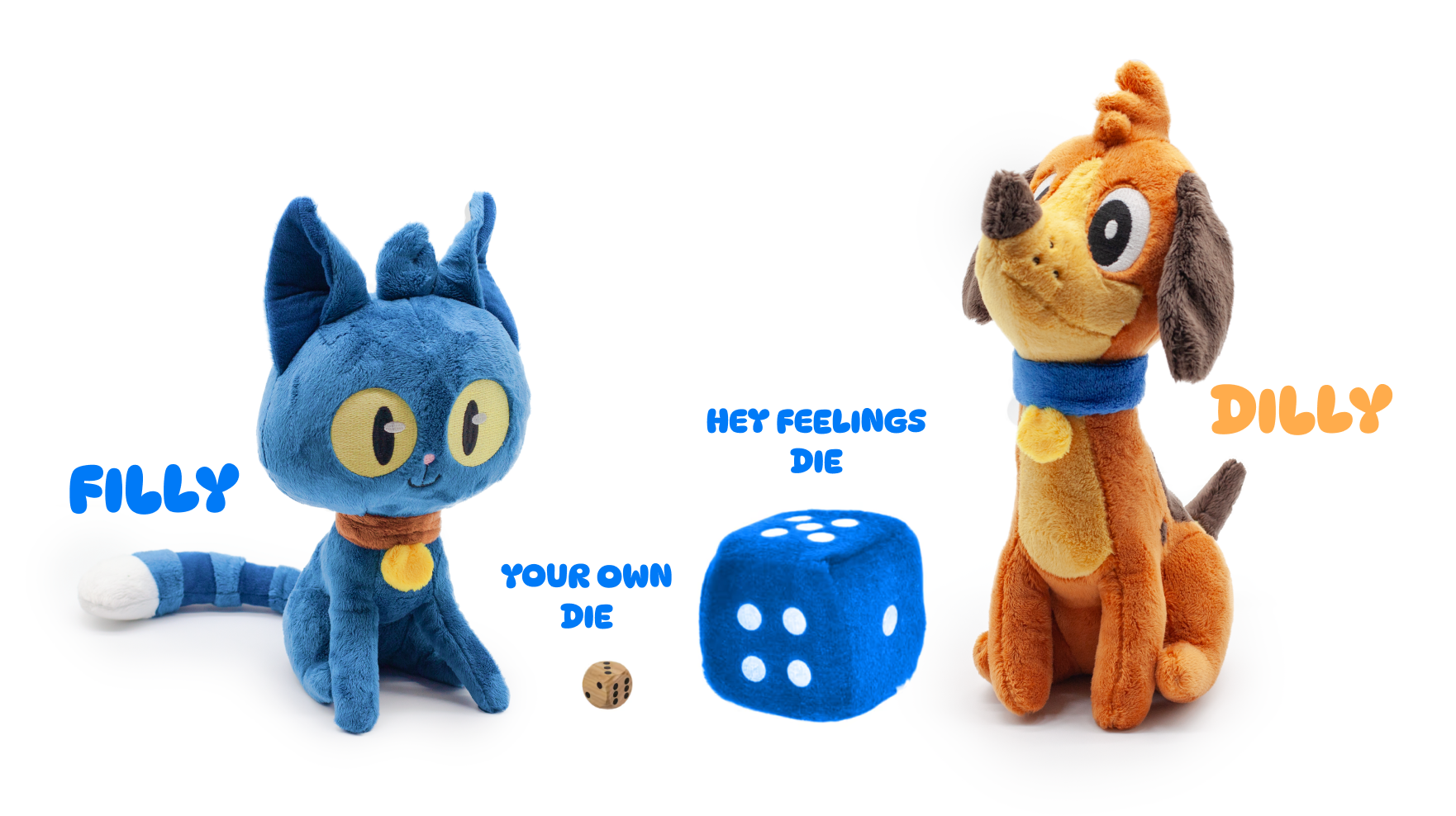
📚 Emotion Books
Option A (Purchased Printed Workbooks): Parents can purchase comprehensive, printed Emotion Books from our Hey Feelings Store. These include activity pages, sticker sheets for the Emotion Diamonds, and more for the entire year.
Option B (Printable PDF Workbook Pages): Alternatively, you can access and download PDF with activity pages directly from the Emotion Books tab. You then print only what you need for a particular group session.

Key Takeaway on Materials: The crucial thing to know right now is that you can begin using Hey Feelings Academy immediately with the digital platform, your own die, and by printing the PDF activity pages as you go. The physical items are wonderful, optional enhancements.
DISCLAIMER
Hey Feelings provides digital and physical tools to support emotional education and therapy. These materials are not a substitute for professional judgment. All online or in-person sessions using Hey Feelings must be facilitated by a qualified therapist, educator, or other licensed professional. Responsibility for the safety, appropriateness, and outcomes of each session lies entirely with the professional conducting it. Hey Feelings and its creators are not liable for any therapeutic decisions, diagnoses, or interventions made while using the platform or associated materials.
The Hey Feelings gamea and all Emotion Worlds are accessed by logging into your account. They will be displayed on your Therapist's dashboard.
No! We believe in letting you experience the value firsthand. The entire Spookyland Emotion World is completely free for you to use. This includes its digital game and any associated printable PDF activity pages. If you're using the digital/printable option, you'll just need a standard six-sided die.
We've designed Hey Feelings to be intuitive and user-friendly. This guide series will break everything down for you step-by-step. This first article gives you the essential overview, and Article 2 will walk you through your very first game session, making it all feel much simpler.
Your First Emotion World Game Session: A Step-by-Step Playthrough
Now, it's time for the exciting part: guiding kids through their very first interactive game session! This article is your friendly, step-by-step companion to ensure that initial experience is smooth, fun, and lays a great foundation for future emotional explorations.
Quick Prep for Your First Group Session
Just 5-10 minutes of preparation before children arrive can make a big difference in ensuring a smooth and engaging start to your Hey Feelings session. Use this quick checklist to get ready.
Essential Tech Check
- Display Connection: Confirm your computer is reliably connected to your large display (Projector, Smartboard, or TV). See the Pro Tip on Display Connections at the end of this article for a quick refresher!
- Sound Check: Ensure audio is working correctly through your chosen display or external speakers. A quick test with any sound from your computer will do.
- Internet Stability: Verify you have a stable internet connection. It doesn't have to be fast.
- Platform Access: Be logged into the Hey Feelings Academy platform as you are now.
Simple Setup
Group Areas: Arrange two distinct, comfortable areas for both groups, positioned side-by-side so everyone can clearly see the main display with the game. This allows for better visibility than having one group behind another.
Your Hub: Make sure your computer or laptop is placed where you can easily access it to control the on-screen game, while still maintaining a good view of both the screen and children.

Materials Needed for This Session
Standard Die:
You'll need one standard six-sided die for gameplay. Optionally, if you have purchased the large, soft Hey Feelings Plush Die, this is a great tactile option to use!
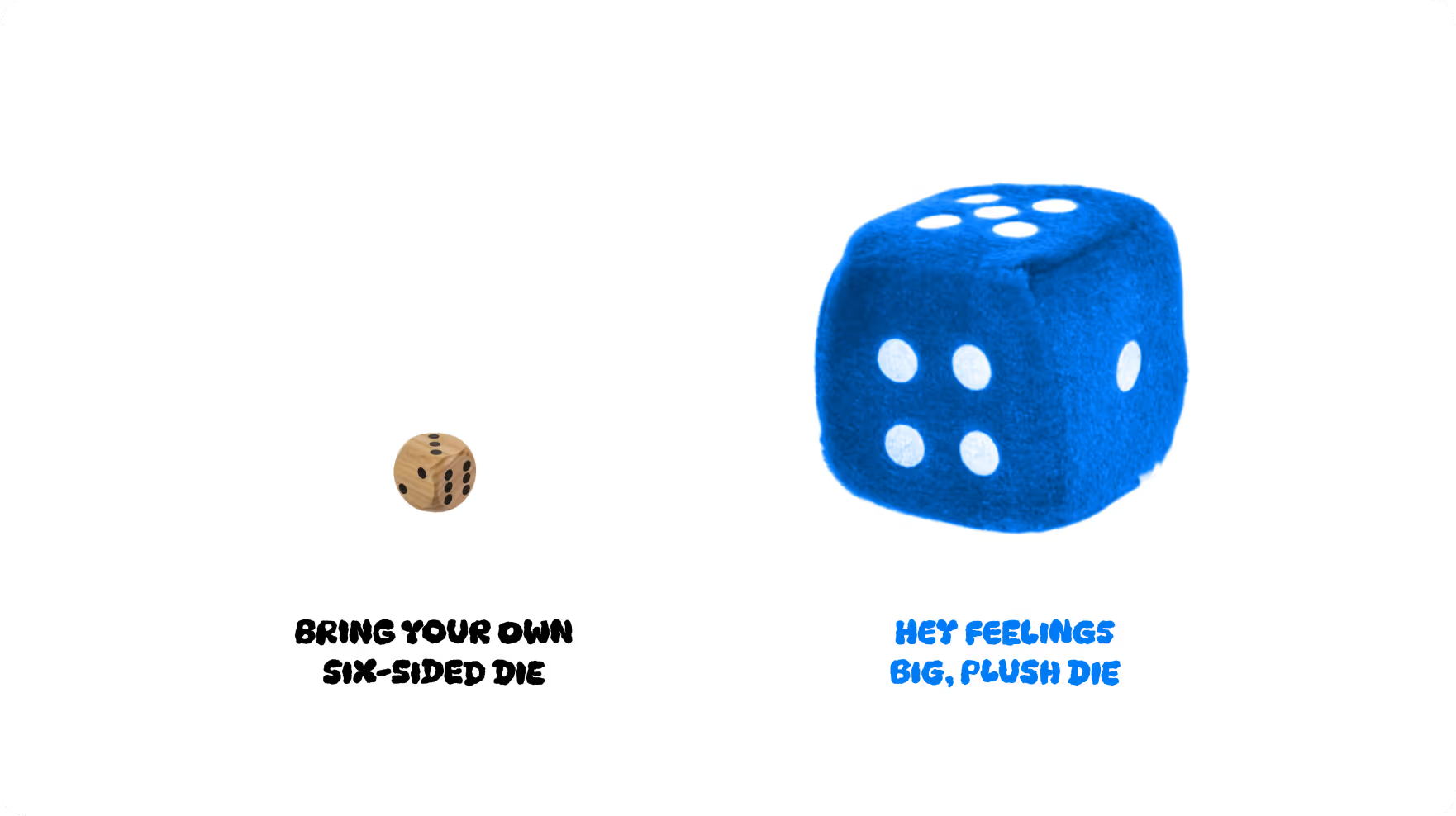
Filly & Dilly Mascots (Optional):
If you have purchased the Filly and Dilly Plush Mascots, have them ready to assign one to each group. These can enhance engagement and make turn-taking more tangible.
Important Note: This step is optional. You can absolutely play Hey Feelings Academy effectively without the physical plushies. The on-screen Filly and Dilly pawns will represent the groups in the digital game.
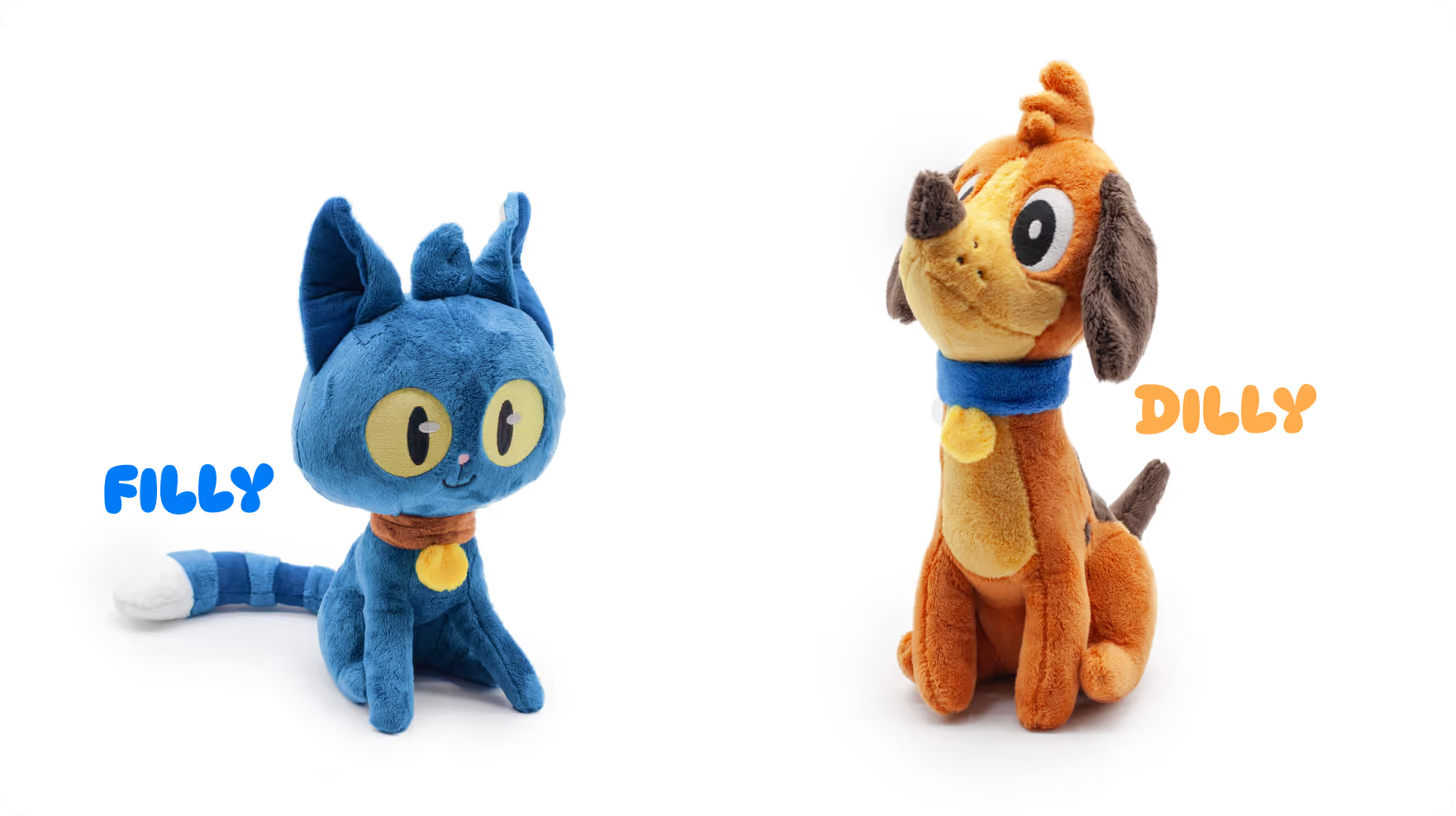
Emotion Workbooks (Choose Your Option):
- Printable PDF Workbook Pages: If you are using the printable PDF workbook pages (accessed via the Emotion Books tab), focus on core digital play, no specific PDF printout is strictly necessary for the gameplay itself. Diamond collection will be tracked digitally on-screen. You will print specific PDF pages for other, subsequent activities, as detailed in Article 4 ("The Emotion Books").
- Purchased Printed Workbooks: If you have purchased the physical, printed Hey Feelings Emotion Workbooks, you will distribute these at the start of your very first Hey Feelings session. For this gameplay lesson unit children will use their Emotion Books to place any collected Emotion Diamond Stickers (found within their books) onto the designated Spookyland pages. Children apply stickers from their own book when their group collects a diamond in the game.
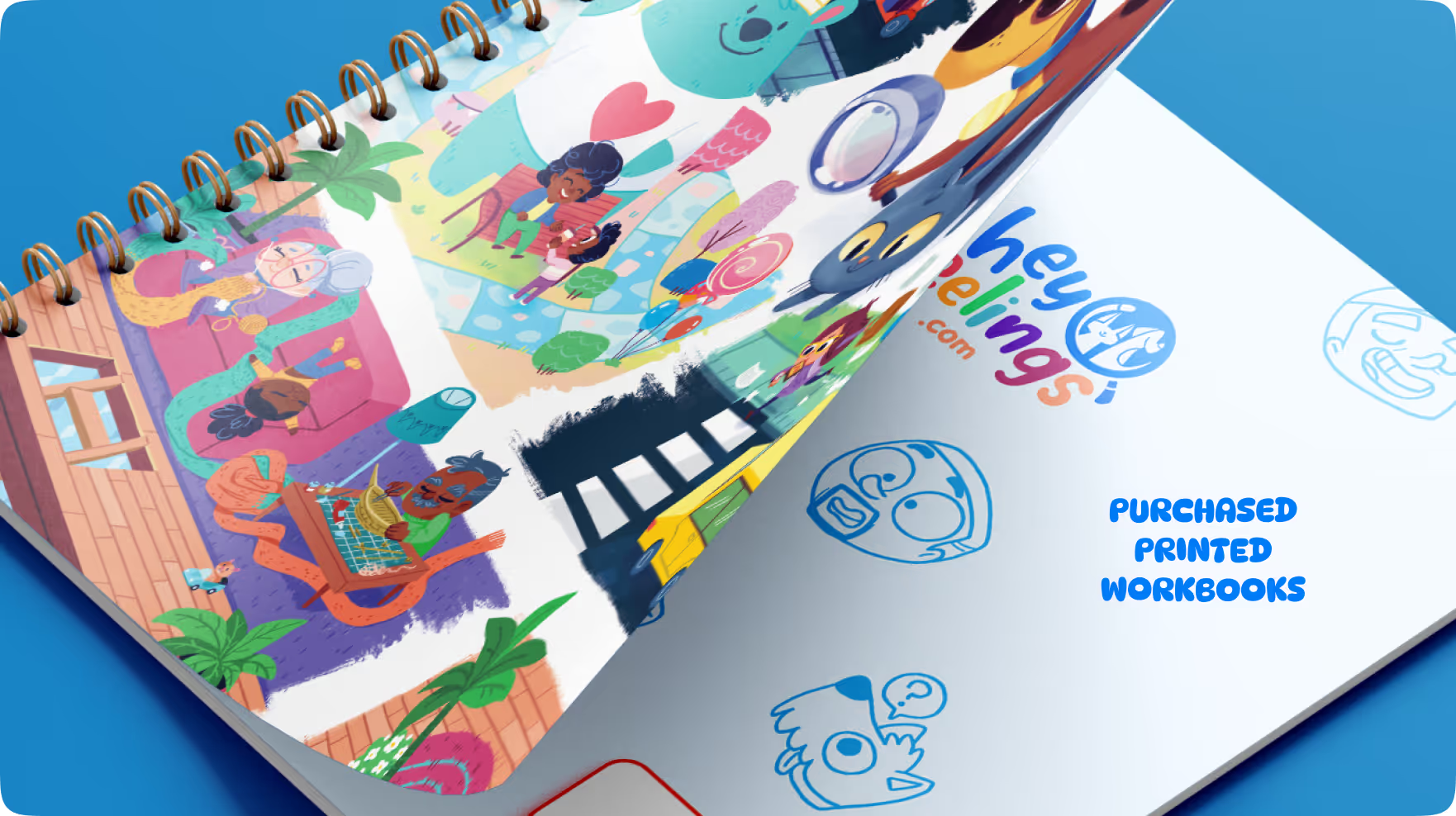
The Opening Story:
The "Spookyland - Introductory Story" will be displayed on the screen when you start the Emotion World on the platform.
However, if you prefer reading from a physical paper copy, you can find and print the Spookyland World - Introductory Story PDF. This will typically be located in the therapist's resources or Emotion Books section for the Spookyland World on the Hey Feelings platform.
Let's Play! Launching & Starting the Game
After logging into Hey Feelings Academy, click on the Spookyland Emotion World tile. This will launch the game environment for that world in full screen mode. You can exit full screen anytime by clicking the eye icon in the top right corner.
You'll see the Opening Story, the Video Intro, and beautifully animated Spookyland game board - ready for kids' emotional adventure to begin!
Psst! There are Ester Eggs on each world. Cute, tiny animations that are visible only for a second, try to find them all. Look for ghosts, hedgehogs, hamsters, etc.
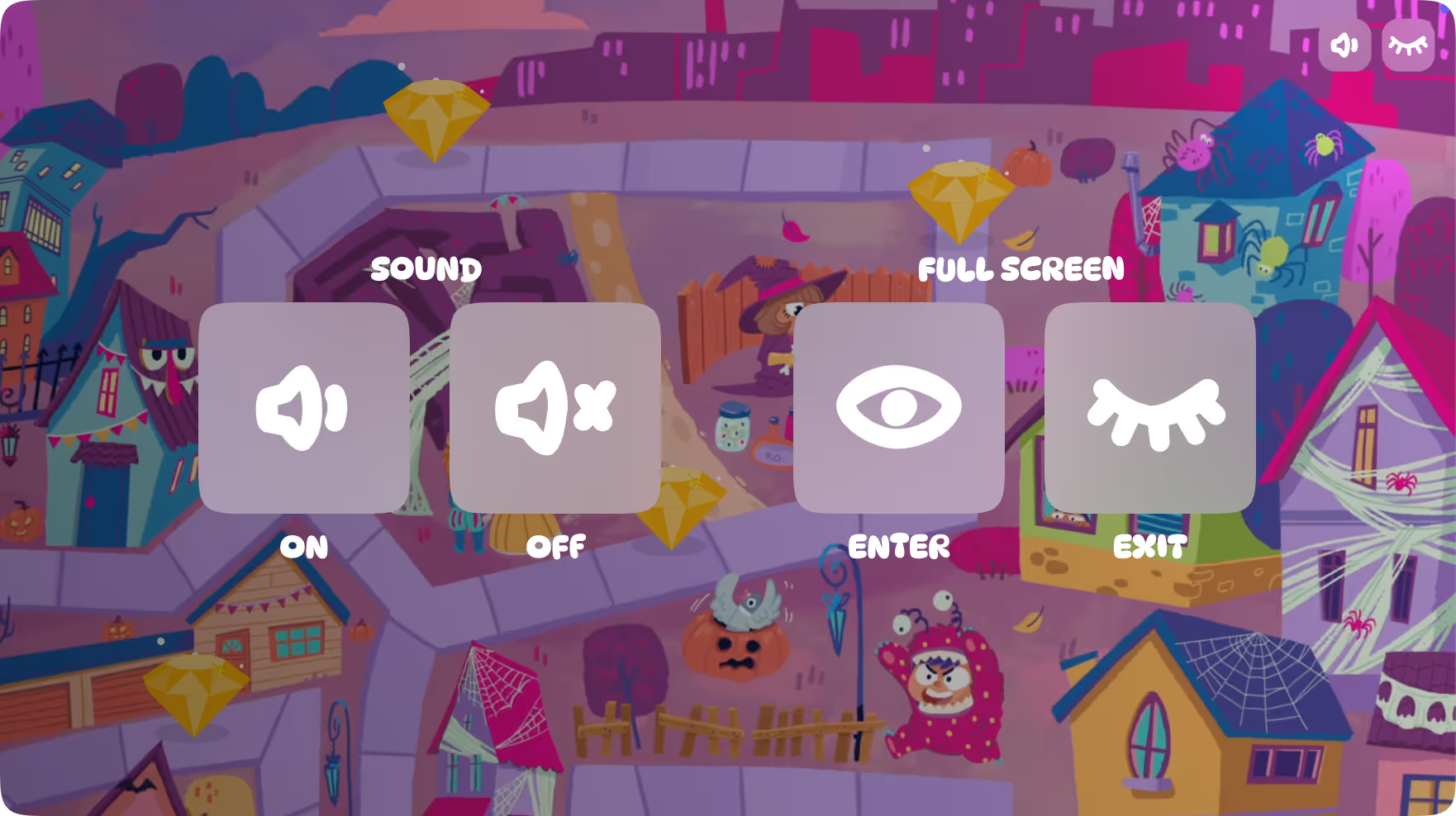
A Step-by-Step Gameplay Walkthrough (group session)
Allow 30-40 minutes for gameplay. Here’s how a typical first game session flows:
Team Time! Organizing Groups & Turns (Approx. 2-3 minutes)
- Form Teams: Verbally divide children into two teams. You can call them "Filly's Group" and "Dilly's Group" – these names correspond to the cat and dog character pawns they'll see moving on the game board.
- Crucial Step: Establish Turn Order: This is key to a smooth game!
- Within Each Group: Quickly help each group decide the order in which their members will take turns rolling the die. For example, you might say, "In Filly's group, Maya will roll first, then Leo, then Chloe. In Dilly's group, Sam will be first, then Priya, then Ben." A simple "around their circle" or a pre-designated sequence works well.
- Starting Group: Determine which of the two groups will take the very first turn of the game. Make it fun and fair – perhaps "the group that can quietly show me they're ready first!" or a quick therapist's choice.
Setting the Scene: The Opening (Approx. 5 minutes)
- Read or Listen to the Story: The game will first present the Opening Story specifically written for the each world. Read this aloud or play the pre-recorded audio (this option will be available shortly). If you printed it, you can use your copy, otherwise, it's clearly displayed on screen.
- Watch the Video: Following the story, a short, engaging Mood-Setting Video Clip will play automatically on the screen. This brief animation helps children transition from the story and focus their attention for the game ahead.
- Hit Play the Game button
The Gameplay Loop: Your First Few Turns Explained
This is the core rhythm of the game, repeat as needed:
- Turn Leader Rolls the Die: The designated "Turn Leader" from the starting group takes the die and rolls it.
- The Turn Leader Decides Where to Move
- Based on the number rolled, the Turn Leader now looks at the board and decides which direction they want to move their group's on-screen pawn (either Filly or Dilly).
- Key Reminder: Encourage the Turn Leader by saying something like, "Look at your number, Maya! Where do you want Filly/Dilly to go? Remember, in Hey Feelings, you can move your character any way you like along the paths! Your goal is to land on, or jump over, an Emotion Diamond!" (The child can briefly consult with their group for ideas, but the final decision rests with the Turn Leader).
- Therapist Action: Following the Turn Leader's decision, you will use your computer's mouse or trackpad to move their group's virtual pawn on the main screen according to the number they rolled and the direction they chose. Just drag the pawn, simulate the movement like on a physical board game and drop the pawn by releasing the mouse button.
- Collecting Diamonds & Revealing Question Cards
- Collect the Diamond: If your group's pawn (Filly or Dilly) successfully lands on or passes directly over an Emotion Diamond during its move, that diamond is considered "collected"!
- Click to Reveal: Click on the diamond on the screen. This action will cause the Question Card related to that specific Emotion Diamond to immediately appear.
- Answer & Update: Once the question from the card is answered by the Turn Leader (and/or discussed by the group, if applicable), and the card is closed, the on-screen diamond counter for that group will update automatically, reflecting their successful collection.
- Engaging with the Question Card – Sharing Our Thoughts:
- Read Aloud: Read the question or task from the displayed card clearly and engagingly to the whole group.
- Child Responds First: The child whose turn it was (the one who rolled the die) gets the first opportunity to answer the question or perform the task.
- Basic Facilitation (Keep it simple for this first game): Offer warm encouragement: "That's an interesting thought, Tim!" or "Great try!" Praise their effort, no matter the answer. If they are hesitant or seem stuck, gently ask their group for support: "Would anyone in Tim's group like to help with an idea or share what they think?" Remember, the goal today is positive participation and familiarization, not perfect answers. (We'll cover more advanced facilitation techniques to deepen discussions in Article 3).
- Passing the Turn – Sharing the Adventure:
- The die (or simply the turn to roll) now passes to the other group.
- The next child in that group (according to their pre-established turn order) is now the "Turn Leader" ready for their turn.
Repeat this gameplay loop (Roll → Move → Collect Diamond → Reveal Question → Answer/Discuss → Pass Turn), alternating between Filly's Group and Dilly's Group. Let the children enjoy the journey!
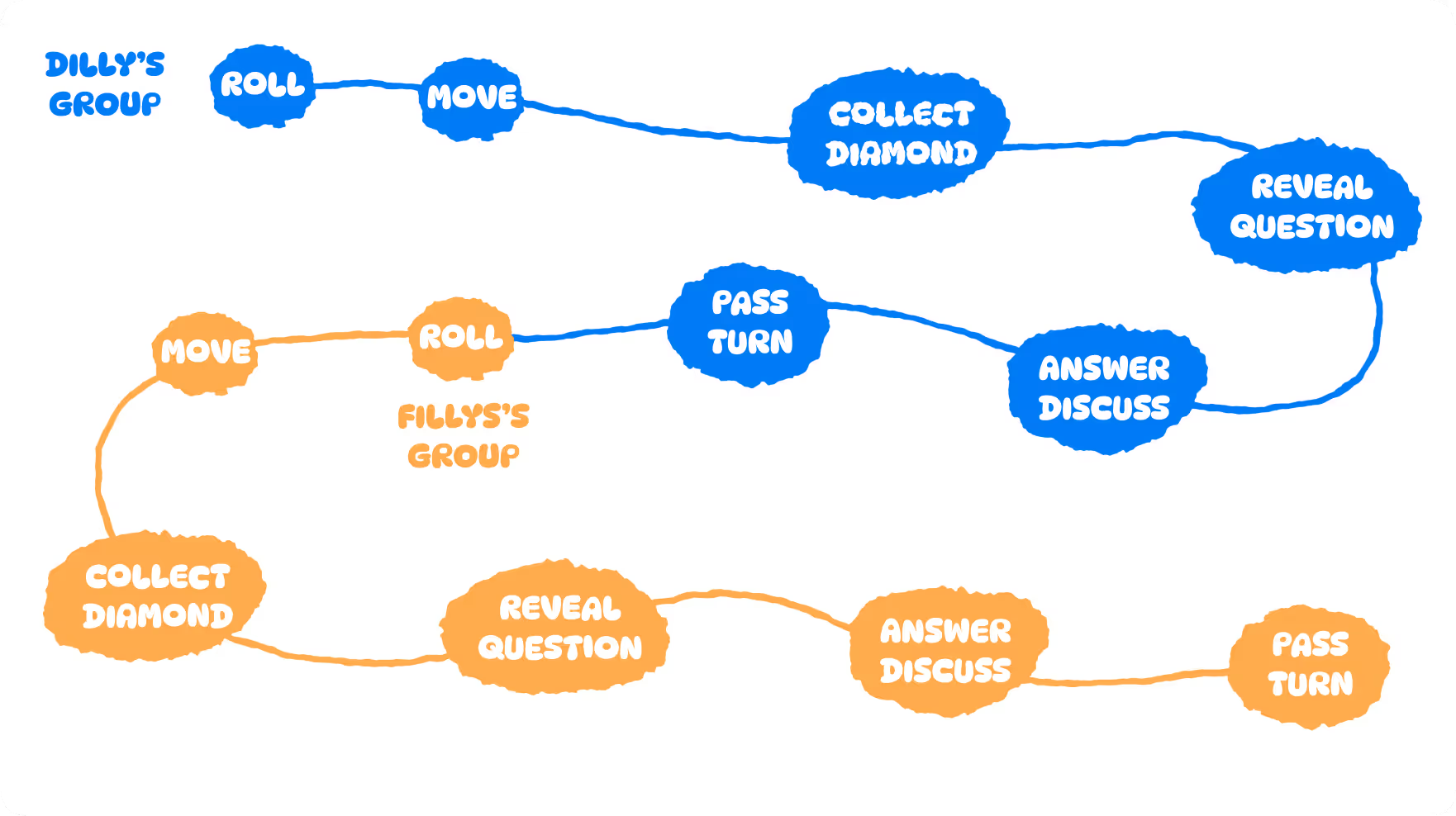
Concluding the Game Session:
- Aim to play for a duration that keeps children engaged for their first experience – perhaps 20-30 minutes of active gameplay after the introduction.
- You don't have to collect all the Diamonds!
- When you're ready to finish the session, you can click the "Pause" button on the game interface. This will usually then reveal an "Exit" option to click.
Wrapping Up Your First Group Session
A brief approx. 5 minutes, positive wrap-up helps consolidate the experience:
Quick Group Reflection:
Gather the children for a brief chat. Ask simple, open-ended questions like:
- "What was one fun part of playing the Hey Feelings game today?"
- "Can anyone remember one feeling we talked about in our adventure today? Why is it important?"
Positive Closure & Looking Forward:
- Praise everyone enthusiastically for their wonderful participation, for listening to each other, and for bravely exploring new feelings and ideas together.
- Let them know you're excited to play Hey Feelings again with them soon and explore more Emotion Worlds
Pro Tip on Display Connections
For the simplest and usually most reliable setup for projecting Hey Feelings, connect your computer directly to your TV or projector using an HDMI cable. This single cable typically carries both sound and video, which reduces complexity. Once you've plugged it in, take a quick moment to check your computer's display settings (you can often find these by right-clicking on your desktop or looking in your System Settings/Control Panel) and ensure it's set to "Duplicate" or "Mirror." This means that what you see on your laptop screen is exactly what the children will see on the big screen. A quick test of this before children arrive can save a lot of troubleshooting time and help your session start smoothly!
🎥 Online Play with a Therapist
Online sessions with Hey Feelings make it possible to bring the same playful, therapeutic experience directly into a child’s home. Using any common video platform, the therapist runs the game in real time while the child follows along, makes choices, and responds to questions — just like during an in-person session.
Whenever possible, we recommend beginning with live, in-person sessions to build trust and familiarity. However, if this is not an option, the program can also be delivered fully online.
To make these meetings smooth, safe, and engaging, we recommend setting up a simple structure that ensures both technical readiness and emotional comfort for the child. Below you’ll find the key setup guidelines and checklists.
1) Purpose and Core Setup
- Format: 1:1 through any video platform (Google Meet, Zoom, Teams…).
- Control: the therapist shares their screen and runs the entire game; the child watches, listens, makes choices, and answers questions.
- Therapist’s role: plays as one of the characters (Filly/Dilly), asks Emotion Card questions, models responses, and can also answer as a “co-player.” The child plays as one of the other characters.
- Safety: child wears headphones, camera on. No session recording unless agreed by both therapist and parent.
- Recommendation: start with live/in-person sessions, then smoothly transition to online.
2) Before You Start — Quick Checklists
Equipment & Setup
✅ Stable internet connection (min. 10 Mbps)
✅ Therapist’s laptop/PC with mouse or touchpad
✅ Video platform with screen + sound sharing enabled (Meet/Zoom)
✅ Child’s headphones + camera on
✅ Quiet room with good lighting
✅ Meeting link sent in advance with short instructions
Child’s Environment
✅ “Safe spot” – table/desk, chair, no distractions
✅ Glass of water, small fidget toy if needed
✅ Parent available for technical support — decision between therapist & parent whether to stay in or outside the room (best if not listening closely, so the child feels free)
Consent & Privacy
✅ Consent for participation in online sessions (GDPR/RODO compliant)
✅ No recording by child/parent/therapist unless agreed in writing
✅ Clear stop rule (e.g. using the word “STOP” for breaks or leaving the session)
Parent Updates After a Session
It can be very helpful to send parents a short summary after each session. A few sentences about the theme you explored, how the child engaged, and a small takeaway or practice for the week keeps families informed and strengthens the home–therapy connection.
Parent-Friendly Summary
Consider sharing a simple description of how online sessions work. Parents should know that the therapist runs the game by sharing their screen, plays as a character, and interacts with the child in real time. It’s recommended that parents stay nearby for support, but not actively listen in, so the child feels more open. Headphones and the camera on help with focus and comfort. Families should also understand that in-person sessions are the best starting point, with online meetings introduced gradually.
Mini Instructions to Send With the Meeting Link
When sending the meeting link, include a short checklist for preparation, such as:
- Quiet spot with a table/desk and no distractions
- Laptop or computer (not a phone), with camera and microphone on
- Headphones (recommended)
- Glass of water and a small fidget toy if useful
- Parent available for technical help, but allowing the child to interact freely
- Join 5 minutes early to test sound and video
DISCLAIMER
Hey Feelings provides digital and physical tools to support emotional education and therapy. These materials are not a substitute for professional judgment. All online or in-person sessions using Hey Feelings must be facilitated by a qualified therapist, educator, or other licensed professional. Responsibility for the safety, appropriateness, and outcomes of each session lies entirely with the professional conducting it. Hey Feelings and its creators are not liable for any therapeutic decisions, diagnoses, or interventions made while using the platform or associated materials.
First, double-check that your computer's display settings are definitely on "Duplicate" or "Mirror" mode (so you and the children see the same thing). Ensure all cables (especially HDMI, if you're using one) are securely connected at both ends. Also, make sure your projector or TV is set to the correct input source (e.g., HDMI 1, HDMI 2). Sometimes, a quick restart of your computer or the display device can resolve connection issues.
That's a common point of learning for the first game, and that's okay! Pause the game briefly. Gently re-explain that they have lots of choices and can move their character any way they like along the paths on the board. You could even model one or two moves yourself on the screen, thinking aloud: "Hmm, that yellow diamond looks interesting! Maybe Filly's group could go up this path, and then across here..." Encourage them to point to where they want to go and discuss it as a group.
Don't worry too much, especially in this first session! Acknowledge it with a light-hearted "Oh, my click went a bit wobbly there! Let's carry on from here." The main focus today is on familiarization and positive interaction. (Article 3 will cover how to use User Interface features like manual diamond adjustment for more precise corrections if needed in future games).
For this first game, the absolute priority is creating a positive, safe, and encouraging atmosphere. Offer very gentle encouragement. Praise any attempt to answer, even if it's just a word or a gesture. You can also say something like, "That's a thoughtful idea. Does anyone in your group want to add to that, or share what they were thinking too?" Avoid putting any child on the spot or making them feel pressured.
Session Guide & Facilitation Across All Worlds
Welcome back! Now that you've successfully navigated your first Hey Feelings game session (as detailed in Article 2), you're ready to delve deeper and truly master the art of gameplay. This article will equip you with advanced knowledge of the Hey Feelings platform features, more nuanced techniques for fostering rich emotional discussions, and strategies for effectively managing group dynamics. These skills will empower you to create even more impactful learning experiences across all six Emotion Worlds. Let's level up your Hey Feelings expertise!
Beyond the Basics: Fine-Tuning Your Game Control
You've got the core game flow down: rolling the die, guiding pawn movement, seeing diamonds collected, and discussing Question Cards. Now, let's explore some platform features that give you even greater control and flexibility:
Quick Recap: Core Gameplay Loop
Just to refresh, the basic cycle is:
- A child from the "active group" rolls the die.
- The “Turn Leader” decides how to move their pawn (Filly or Dilly), aiming to land on or pass directly over an Emotion Diamond.
- Click on a diamond to collect it.
- Question Card automatically appears.
- "Turn Leader" and/or the group discusses the card, and then the turn passes.
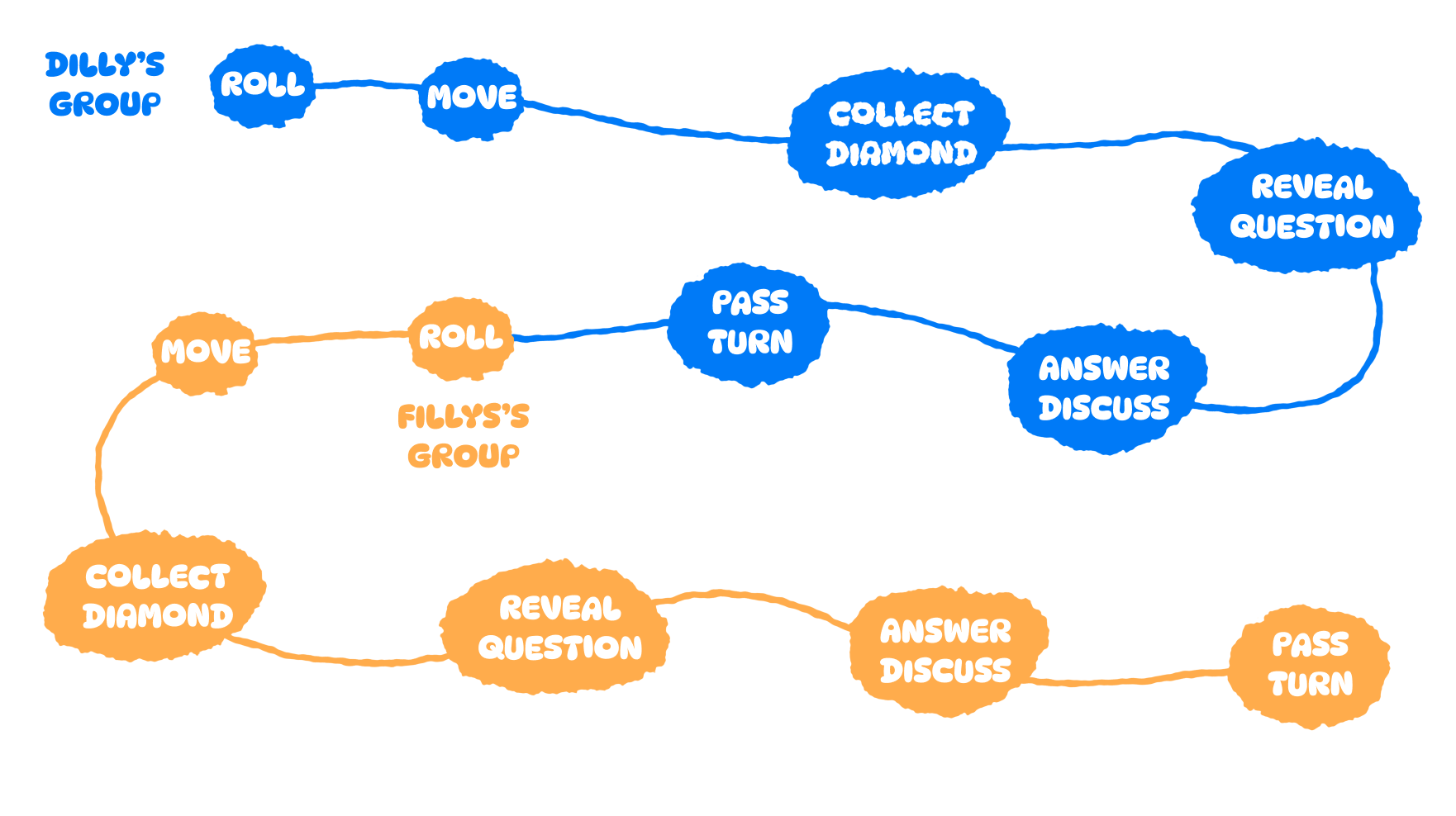
Precision Tool: Manual Diamond Adjustment
Sometimes, a click might be missed, or a diamond might be awarded when it shouldn't have been. Don't worry! The on-screen diamond counters for Filly's Group and Dilly's Group are interactive.
- How to Use: Simply hover your mouse cursor directly over your group's diamond total displayed on the game screen. You'll see small "+" (plus) and "-" (minus) icons appear next to the number.
- Purpose: Clicking these icons allows you to manually add or subtract a diamond from a group's score. This is a handy tool for making quick corrections and ensuring the on-screen score accurately reflects the gameplay.
Key Element: The Hey Feelings Cards
Within each Emotion World, you'll discover a set of fun and engaging cards. These feature a mix of playful activities and thoughtful questions, all designed to effortlessly impart key SEL knowledge. Dive deeper into the complete card collection under the Emotion Books.
Before a session where you plan to explore a new Emotion World, take a few minutes and go over all Question Cards. This allows you to familiarize yourself with the range of topics and discussion prompts for that specific world. It can help you anticipate potential conversations and even prepare some of your own insightful follow-up questions to deepen the learning.

The Game Changer: Understanding and Using Booster Cards
One of the most exciting elements of Hey Feelings is the Booster Card feature! These are an automatic surprise that activates whenever a "1" is rolled on the die. If you have Hey Feelings Plush Die, there will be a cat & dog symbol isntead of "1"
Instead of a "1" being a low or disappointing roll, it transforms into a fun "superpower" or positive event for the group! Examples include:
- Double Move: Roll the dice two times
- Triple Up: Roll the dice three times
- Freeze: Freeze the other group for one round
- Swap: Swap the pawns with the other group if you like
- Diamond Magnet: You’re magnetized. Pull in a nearby Diamond!
- Mega Jump: Jump one spot ahead of the other group
- Time Machine: The other group moves back to their previous spot
- Teleport: Move to anywhere except spots with Diamonds
Your Role: When a Booster Card appears on screen, read its text aloud with enthusiasm! Help the group understand its effect and how to apply it during their current turn. This adds a wonderful element of surprise and fun.

The Hidden Helper: Accessing the In-Game Side Menu
There's a useful menu tucked away for quick access to card information To access it, gently hover your mouse cursor over the far-left edge of the main game screen. A side menu will slide out from the left.
Key Features of the Side Menu:
- Manually Select Question Card: This option empowers you to intentionally choose and display any single Question Card from the current Emotion World. Instead of relying on the game's progression, you can handpick a specific card to guide the discussion, revisit an important point, address an immediate group need, or ensure a particular theme is explored.
- View Booster Card Options: This lets you see a list or description of the possible Booster Cards that can appear in the game. This is primarily for your reference, so you understand the range of "superpowers" that might pop up.
Elevating Your Facilitation: Sparking Deeper Emotional Learning
The Question Cards are fantastic starting points, but your facilitation is what truly unlocks deep learning. Here’s how to take your discussions to the next level:
Beyond the Card: Asking Probing & Extending Questions
Don't feel limited by the exact text on the Question Card. Use it as a springboard for richer dialogue:
- "That's what the card asks... but what do you think might happen after that character does that?"
- "Can you think of a time in a book you've read, or a movie you've seen, when a character might have felt this way?"
- "If you could give that character in the story some friendly advice right now, what would it be?"
Fostering Elaboration & Critical Thinking
Encourage children to expand on their initial responses:
- "That's an interesting point! Can you tell me a little more about why you chose that answer?"
- "What makes that feeling feel strong for you, or maybe just a little bit strong?"
- "Are there different kinds of [the emotion being discussed, e.g., 'scared']? Can you describe one?"
Active Listening & Validation – Creating True Emotional Safety
Your responses model kids' emotional intelligence. Reiterate the importance of being non-judgmental: "Thank you for sharing that, Matthew. It's brave to talk about our feelings."
Show empathy in your replies: "It sounds like that was a really frustrating situation for you when that happened," or "I can understand why that would make you feel excited!"
Connecting to Real Life With Care and Respect
Help children see how the emotions and scenarios in the game relate to their own lives, always ensuring a pressure-free environment. Ask questions like "Has anything a bit like that ever happened to you, or perhaps to someone you know?"
Important Note: Always respect a child's choice not to share personal details. Create an atmosphere where sharing is invited but never forced. Prioritize their comfort and emotional safety above all.
Tips for Smooth & Fun Group Sessions
A lively Hey Feelings session means active group play! Here are some tips to keep group play flowing.
🤝 One Group Play – Co-operation Mode
For younger children, you can switch from two competing groups to One Big Team. Instead of splitting into Filly’s group and Dilly’s group, the whole group plays together.
- Kids take turns rolling the dice, then decide together which character (Filly the Cat or Dilly the Dog) should move on the on-screen board.
- The goal here is free exploration of the Emotion Worlds rather than competition between two groups. Both characters collect Emotion Diamonds, but since they represent the same team, everyone celebrates each move.
- This mode encourages collaboration, shared decision-making, and joyful discovery — perfect for younger kids who benefit more from cooperation than rivalry.
👉 Coming soon: age-differentiated Question Cards, so therapist can choose simpler prompts for 4–5-year-olds and more advanced ones for 6–7-year-olds.
👥 Ensuring Equitable Participation & Every Voice is Heard:
Strategic Questioning: After a more vocal child shares, you might gently say, "That's a great point! Mike, I wonder what your thoughts are on this?"
Informal Group Roles: You could subtly encourage different children to be the "lead spokesperson" for their group's answer on different turns, helping everyone get a chance to articulate the group's ideas.
💬 Navigating Disagreements & Fostering Collaboration Within Groups:
Sometimes groups will have different ideas about how to move their pawn or answer a question. This is a learning opportunity! "Okay, it sounds like Filly's group has two interesting ideas here. How can you decide together which one you'd like to try first for your move?" Frame these moments not as conflicts, but as chances to practice communication and problem-solving.
⏱️ Maintaining Engaging Pace & Flow:
Be mindful of the time spent on each Question Card. If the discussion is rich and productive, allow it to flourish. If it's stalling or going off-topic, gently guide it back or decide it's time to move to the next turn.
Your own energy and enthusiasm are contagious! They play a big part in keeping the session dynamic and enjoyable for everyone.
The on-screen counters are your primary visual reference. If you're ever very unsure after a manual adjustment, you can simply make a mental note and focus on ensuring overall fairness throughout the game or across future sessions. Remember, the precise diamond count is secondary to the quality of the emotional learning and discussion.
Acknowledge their feelings honestly: "I can see you're feeling a bit disappointed that Dilly's group got that lucky Booster Card just now!" Remind them that Booster Cards are an element of surprise and chance, and their group might get a fantastic one on their next "1" roll. Re-emphasize the importance of teamwork, enjoying the process of playing together, and what they are learning about the emotion.
Your calm response is key. Pause the game if necessary. Approach the child calmly and quietly. Acknowledge their feeling directly and validate it: "I see you're feeling very [sad/angry] right now, and that's okay." Offer comfort in a way that is appropriate for your relationship with the child (e.g., a quiet word, offering a moment aside if they need space, a comforting gesture if appropriate). If the child needs more significant support, ensure they receive it, potentially connecting with them more privately after the session. Then, assess whether the group discussion can gently continue on that topic or if it's best to sensitively shift the focus.
The side menu (accessed by hovering on the far-left of the screen) can show a random Question Cards for the current Emotion World. Curently there's no way to show a specyfic card.
The Emotion Books: Extending Learning Beyond the Game
Welcome back! You're now comfortable with running Hey Feelings game sessions (Articles 2 & 3). Now, let's unlock the full potential of each Emotion World by diving into the Emotion Books (Workbooks). These components are key to transforming a single game session into a rich, multi-lesson unit that extends learning and kids creativity.
The Emotion Books: Creative & Reflective SEL Journal
The Emotion Book (whether you're using the premium Printed Books or the flexible Printable PDF Pages from the Academy Platform) is much more than just a place to track game progress. Its true power lies in its ability to:
- Extend and Personalize Learning: Activities within the book allow children to reflect on the emotions explored in the game in a more individual way.
- Facilitate Personal Reflection: Prompts and activities encourage children to think more deeply about their own feelings and experiences.
- Offer Creative Outlets: Coloring pages and other extra materials provide a calming way for children to visually process and express their understanding of emotions.
Quick Recap of Your Two Format Options:
Printable PDF Workbook Pages: You download lesson-specific PDF pages from the Hey Feelings Academy Platform for each activity (e.g., you'll download and print the "Spookyland World - Opening Story" for one session, and the "Fear World - Little Microphones" for another). With this option, there are no physical stickers, diamond collection is tracked on-screen, and rewards are verbal.
Purchased Printed Workbooks: A child has their own comprehensive workbook. It includes all activity pages for every Emotion World, plus integrated Emotion Diamond sticker sheets. Children apply stickers from their own book when their group collects a diamond in the game.

Expanding Each Emotion World with Emotion Book Activities
Here’s a typical flow, integrating Emotion Book components:
Lesson 1 - Playing the Game
Introduction & Core Gameplay, typically for a New Emotion World Unit. Immerse children in the theme of the new Emotion World and have an engaging initial game experience.
Activities:
- Read the Opening Story for the current Emotion World (this can be read from the platform, or children can follow along if they have the physical Emotion Books).
- Play the short Mood-Setting Video Clip from the platform.
- Conduct a Main Hey Feelings Game Session (refer to Articles 2 & 3 for detailed gameplay guidance).
Emotion Book Integration:
- Purchased Printed Workbooks: Children should turn to the section for the new Emotion World. As their group collects Emotion Diamonds during the game, each child in that successful group takes a corresponding sticker from their own sticker sheet and places it in their book.
- Printable PDF Workbook Pages: Not needed. Focus is on the digital gameplay and on-screen diamond tracking.
Additional Activities: Coloring Pages and others
Allow children to visually process the emotion, engage in a calming reflective activity, and reinforce the themes of the current Emotion World.
- Distribute the Coloring Pages designed for the current Emotion World. These will be pages in their printed Emotion Book, or specific PDF pages you've downloaded and printed from the platform's resource section for that World.
- Facilitate During Coloring: As they work, circulate and encourage quiet conversation. You might ask: "What do you see in this picture that reminds you of our [Current Emotion] World?" "What colors are you choosing for that part, and why?" "How does this picture make you feel?"
- Optional Follow-up: You could follow this with a very short (5-10 minute) game session for the same Emotion World, focusing on just a few Diamond questions, or have a brief group share where children can show their finished coloring pages if they wish.
This is a crucial aspect of effective SEL. Always be mindful that overt expressions of emotion, and individual comfort levels with sharing personal feelings, can vary significantly across different cultures and family backgrounds.
Focus your discussions on the universal underlying feelings (e.g., the idea that everyone, everywhere, experiences happiness, sadness, fear, or anger sometimes, even if they learn to show or talk about it in different ways).
Use inclusive language throughout all your Hey Feelings sessions. If a child shares a perspective on an emotion that is clearly rooted in their cultural background or family traditions, validate it as a valuable and interesting contribution to the group's broader understanding.
The aim is to create a brave and respectful space where all experiences and perspectives feel honored.


